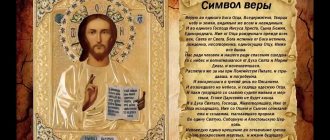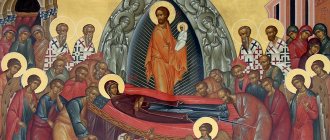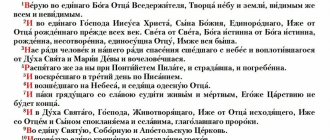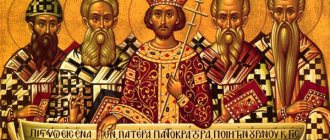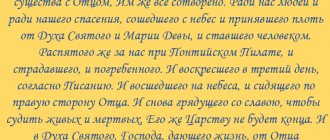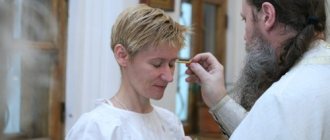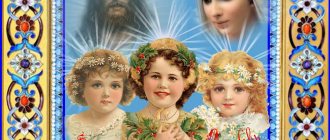Baptism is the first and most significant event in a child’s life. According to church rites, the sacrament of Baptism should take place on the 8th and 40th days from the birth of the baby. But in principle, parents can independently choose the time for the ceremony.
The choice of godparents is of great importance, since serious responsibility will rest on their shoulders.
It is important not only to know prayer texts by heart, but also to understand their meaning. During the sacrament, they are pronounced by the priest, so you can simply repeat the words after him in a whisper.
Creed text
1. I believe in one God, the Father, Almighty, Creator of heaven and earth, visible to all and invisible.
2. And in one Lord Jesus Christ, the Son of God, the only begotten, who was born of the Father before all ages, Light from Light, true God from true God, begotten, uncreated, consubstantial with the Father, by whom all things were.
3. For our sake, man and our salvation came down from Heaven, and became incarnate from the Holy Spirit and the Virgin Mary, and became human.
4. She was crucified for us under Pontius Pilate, and suffered and was buried.
5. And he rose again on the third day according to the Scriptures.
6. And ascended into Heaven, and sits at the right hand of the Father.
7. And again the coming one will be judged with glory by the living and the dead, His Kingdom will have no end.
8. And in the Holy Spirit, the Lord, the Life-Giving One, who proceeds from the Father, who with the Father and the Son is worshiped and glorified, who spoke the prophets.
9. Into One Holy Catholic and Apostolic Church.
10. I confess one Baptism for the remission of sins.
11. I hope for the resurrection of the dead.
12. and the life of the next century. Amen.
Who composed the creed? The doctrine of faith was set out in this way by the fathers of the First and Second Ecumenical Councils.
What is an Ecumenical Council? The Ecumenical Council is a meeting of pastors and teachers of the Christian Catholic Church, if possible from the entire Universe, for the establishment of true teaching and decency among Christians.
What you need to know about prayer
- The Creed is included in the morning prayers.
- It is read at every Divine Liturgy in cathedrals and churches.
- Every Orthodox person should know the Symbol by heart. It is necessary to learn it even before receiving Baptism in order to have correct knowledge about God and His Teachings.
- During the celebration of the Sacrament, godparents must also know it by heart and read it without hesitation or mistakes.
Baptism of a child
is important! Understanding the meaning of the lines of the prayer, a Christian will always be able to answer the question: in whom and how do you believe? And the last word is “Amen!” means the truth of the Orthodox faith: “truly”, “undoubtedly”.
About other basic Orthodox prayers:
- “O Mother of God, Virgin, rejoice...”
- "Our Father"
About the members of the Creed
How many parts are there in a creed?
To better understand the Ecumenical Creed, we should pay attention to its division into twelve members, or parts, and consider each member separately.
What does each part of the creed say?
Each part talks about:
1 God, the First Hypostasis of the Holy Trinity - God the Father, Creator of the world. 2 Second Person of the Holy Trinity, about the Lord Jesus Christ, the Son of God. 3 Incarnation of the Son of God. 4 the suffering and death of Jesus Christ. 5 The Resurrection of Jesus Christ. 6 The Ascension of Jesus Christ into Heaven. 7 The Second Coming of Jesus Christ to earth. 8 Third Hypostasis of the Holy Trinity, about the Holy Spirit. 10 Baptism, where other Sacraments are also implied. 11 future (universal) Resurrection of the dead. 12 Eternal Life.
Baptismal prayers you need to know
So, adults and godparents preparing for Baptism must definitely know the prayers “Our Father”, “Rejoice to the Virgin Mary” and meaningfully read the “Creed”. During the sacrament, the priest reads the prayers, but the godparents must repeat these prayers after him.
Regardless of whether it is the christening of a boy or a girl, godparents also need to know the prayer to the Holy Spirit “Heavenly King” and the Most Holy Theotokos “It is worthy to eat.”
Prayer to the Holy Spirit “Heavenly King”
Heavenly King, Comforter, Soul of truth, Who art everywhere and fulfills all things, Treasure of good things and Giver of life, come and dwell in us and cleanse us from all filth, and save, O Good One, the souls of sha.
Prayer to the Most Holy Theotokos “It is worthy to eat”
It is worthy to eat, as you are truly blessed, the Mother of God, the Ever-Blessed and Most Immaculate and the Mother of our God. We magnify Thee, the most honorable Cherub and the most glorious without comparison, the Seraphim, who gave birth to God the Word without corruption.
Creed - translation
I believe - I believe, I am convinced;
About Christ
Only Begotten - the only one; before all ages - before all time, from eternity;
consubstantial with the Father - having the same being (nature) with (God) the Father; By Him all things were, and by Him, that is, the Son of God, all things were created;
incarnate - having taken upon Himself a human body; becoming human - becoming a man like us, but without ceasing to be God;
resurrected - revived: according to Scripture - in accordance with the Holy Scriptures, where the prophets predicted that He would rise from the dead on the third day;
ascended - ascended; at the right hand - on the right side of God the Father;
paki - again, for the second time; the dead - the dead who will then be resurrected;
There will be no end to His Kingdom - after the judgment, His Kingdom will come endlessly; Life-giving - life-giving;
About the Holy Spirit
worshiped and glorified - the Holy Spirit should be worshiped and glorified equally with the Father and the Son, that is, the Holy Spirit is equal to God the Father and God the Son; The prophets spoke - the Holy Spirit spoke through the prophets;
About the Church
Conciliar - consonant, unanimous, embracing people from all over the universe; I confess - I openly confess in word and deed; tea - I'm waiting; And the life of the next century - eternal life will come after the general judgment.
General Information and Importance of Prayer
The “Creed” is one of the fundamental prayers in Christianity, and therefore enjoys special respect among believers. This is a brief summary of the fundamentals of Christian doctrine, which was approved many centuries ago during the Ecumenical Councils. During the First Ecumenical Council, the first seven dogmas were approved, and at the Second, the remaining five were recognized.
The peculiarity of the text under consideration is that in fact it is not a prayer, since it does not address any of the saints. The fact is that in Orthodoxy there are twelve dogmas, and this text consists of twelve parts - one for each of the dogmas.
Thus, the first of the dogmas speaks of God the Father, and the praying person gives him praise from a pure heart. This is followed by six parts devoted to Jesus Christ, which glorify his divine origin, the sacrifice he made for humanity, and the Second Coming. The next two parts tell about the Holy Spirit and about the Catholic Apostolic Church, in which the person praying believes. Afterwards it talks about the sacrament of baptism and the resurrection of the dead, which will occur at the time of the Second Coming.
This prayer is considered one of the most important in Christianity, since it contains the main aspects of the Christian faith. It serves as a reminder to believers of the core principles of this religion and glorifies the Trinity as well as other important aspects of Christianity. With its help, a person can repeat to himself again who and what he believes in in order to remove all doubts from his heart.
It should be intended to be read only at certain times, since the text has a sacred meaning and is not aimed at solving worldly issues. It is appropriate to read it during morning and evening prayer rules. In addition, it is an important aspect of the Divine Liturgy.
Since we are talking about the sacrament of baptism, prayer is proclaimed during its celebration. This means that the child’s godparents must know the text (if a girl is baptized, then the godmother pronounces it, and if a boy, the godfather pronounces it). An adult who is undergoing the sacrament of baptism must read the text independently.
Akathists
The site provides a brief overview of the Creed. In the future, the site will be updated with interpretations of akathists and video clips will be made on these akathists.
When reading the akathist at home, it is advisable to take a blessing from the priest. You can read the akathist at a time convenient for you. The reading of the initial prayers begins as in morning and evening prayers, the end of the reading of the akathist also ends with prayers as in morning and evening prayers.
Akathist is a hymn, glorification of God, the Holy One. As a rule, reading is done standing. But, if you are weak, sick, or cannot stand in front of the icon, you can, for example, listen to the akathist at lunchtime at work. Then, of course, you will not be able to strictly follow all the rules.
What matters is that your heart truly desires to glorify the Lord. Therefore, as the Apostle Paul said: “Pray without ceasing” (1 Thess. 5:17). Nothing should be an obstacle to prayer.
Symbolism of the Sacrament of Baptism
Baptism is one of the most important sacraments of the Christian Church. Therefore, the Creed prayer, which is the most important in Orthodoxy, is used for baptism. The sacrament of baptism represents symbolic cleansing by immersing a person in holy water and saying the appropriate prayers.
In the generally accepted sense, this is a connection with the Orthodox faith and inclusion in the Christian Church. Let us remember the words of the holy Archbishop of the Orthodox Church Simeon of Thessalonica, who said the following:
“Baptism regenerates us with the Holy Spirit. It revives because we once destroyed our first passionless birth...”
His words reflect the meaning contained in Christian images. Baptism serves as a symbol of immersion into the death of material life, in order to then be resurrected in spiritual life. This is the earthly path of cleansing from all sins, liberating the human soul from the slavery of material nature and returning it to immortality.
“We were buried with Him through baptism into death, so that just as Christ was raised from the dead by the glory of the Father, so we too might walk in newness of life” (Apostle Paul, Romans 6, v. 4).
With the acceptance of baptism, a person “dies” in a material essence, bound by vices, being resurrected through Love in the Spirit. In the Orthodox tradition, this Sacrament is equated with the spiritual rebirth of a person.
When infants are baptized, the Creed is recited for them by their godparents.
What else distinguishes Catholicism from Orthodoxy?
Not only in the view of the afterlife and the words of prayer does it differ, as a set of dogmas, the Creed. Catholic prayer, without a doubt, determines the main spiritual difference, namely, a different perception of the Trinity. However, there is another, very important divergence in doctrines relating to the earthly organization of the Church.
Although the Catholic Creed, as a prayer text, does not mention the position of the Pope, it is still included in the list of immutable truths. In the Western religious tradition, it is customary to consider the Pope to be a priori infallible. Accordingly, every saying of the pontiff is an immutable truth for believers, not subject to dispute or discussion.
In the orthodox tradition, the Patriarch does not have absolute power. In the event that his statements, actions and decisions run counter to Orthodox ideas, the Council of Bishops has the right to deprive the person of his clergy. A historical example of this can be the fate of Patriarch Nikon, who lost his title in the 17th century.
Another noticeable difference between the Churches is the position of ministers. In Orthodoxy, not every clergy implies a person’s renunciation of intimate life. Catholic clergy are bound by a vow of celibacy.
How did this concept come about?
Creed is a Western term. It was first mentioned in the texts of the Spanish bishop and theologian Ambrose of Milan, who baptized Augustine Aurelius. The bishop used this expression in his message addressed to Sirius I, who occupied the papal throne at that time.
In the Eastern Christian tradition, another concept is accepted - teachings or confessions of faith. However, many theologians, including those belonging to the Orthodox Church, believe that both terms should be used, since they do not contradict one another. The concepts are not completely analogous.
Over time, with the identification of certain church teachings, for example, Anglicanism, the concept of the Creed expanded. Today there are several dogmas of faith, but each of them is based on the Symbols voiced by the disciples of Christ, the apostles. However, the Apostles' Creed was formulated only in the second century. It acted as a counterweight to the spreading ideas of Docetism and was compiled on the basis of the catechism used for the sacrament of baptism at that time.
